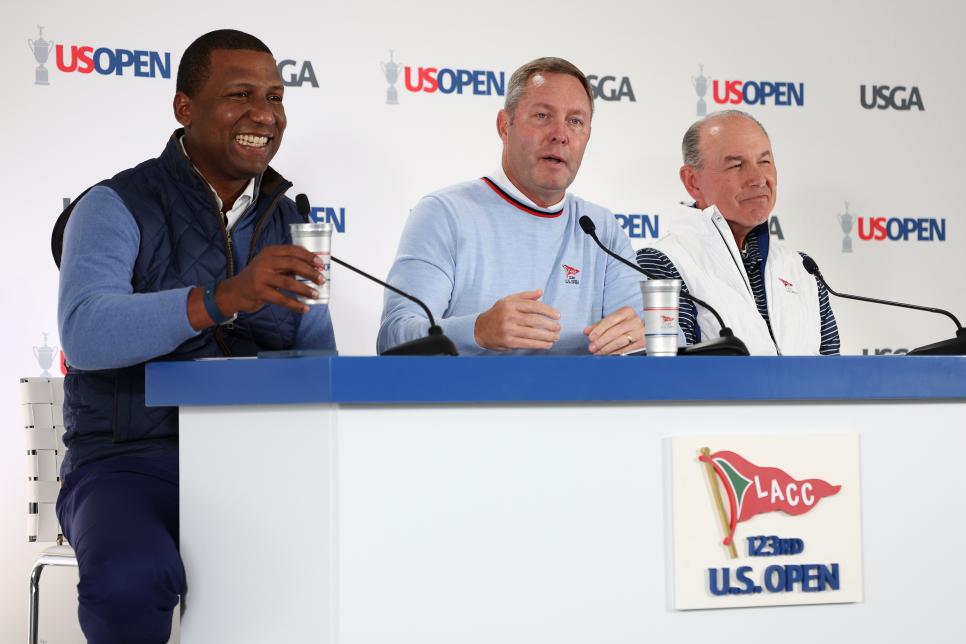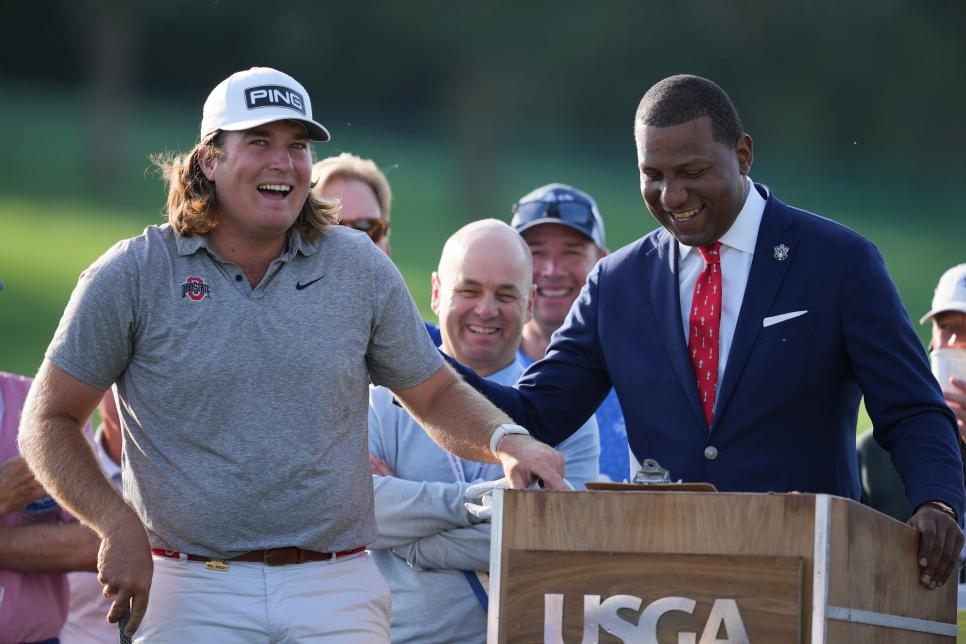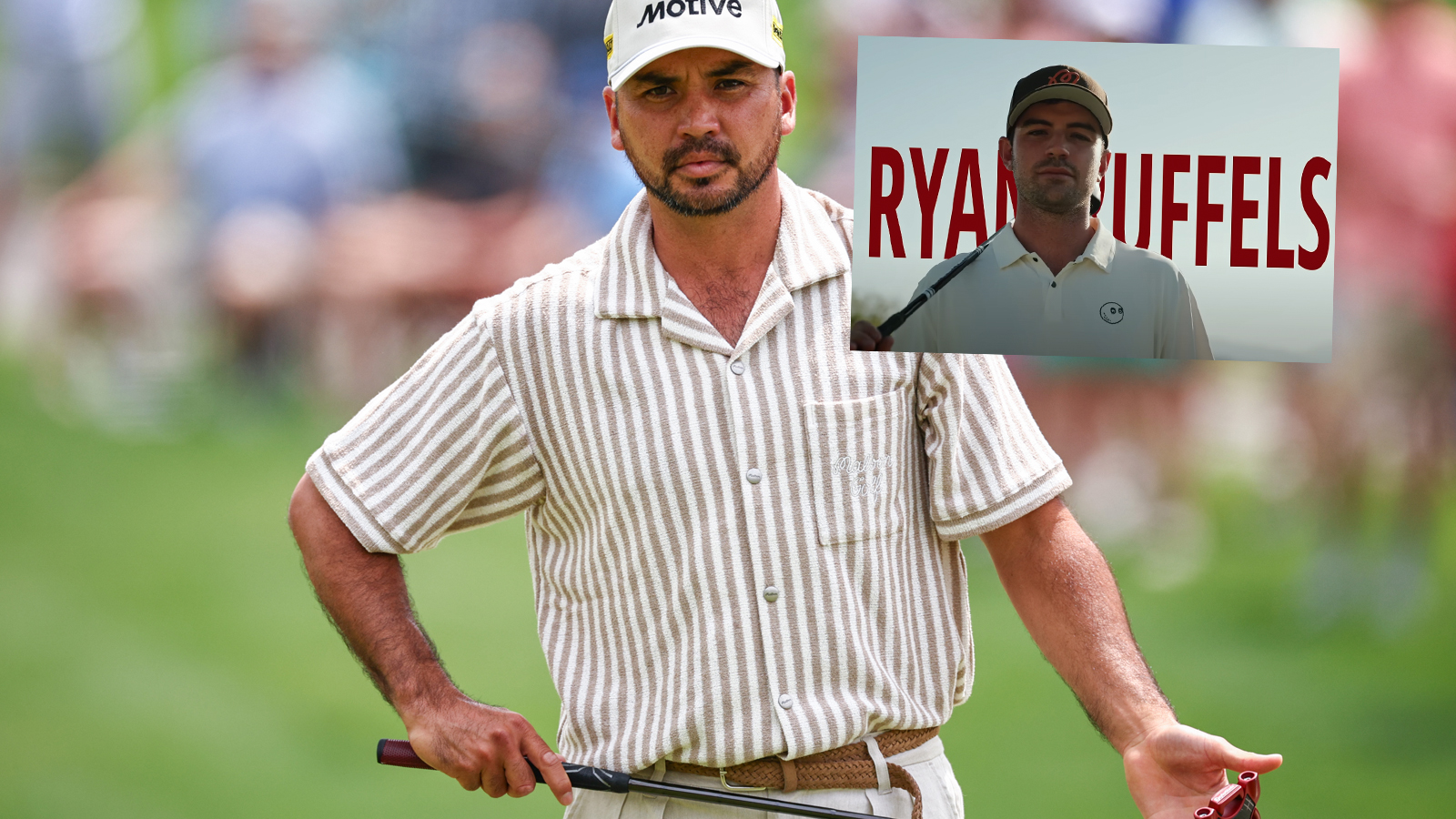‘A new day’: USGA President Fred Perpall brings dynamic personality and drive to golf – Australian Golf Digest

- by Admin
- June 6, 2024

For those who aspire to lead, it’s always helpful to own an authentic personal story. Especially one that matches the moment.
To golf’s great benefit, that’s precisely the case with Fred Perpall.
For the past 18 months, the 49-year-old CEO of a Dallas architecture firm has been USGA president. As the first Black man among the 67 to have held the position since 1894, Perpall’s tenure has already been historic. But it promises to be even more so.
MORE: U.S. Open 101: Everything you need to know about this year’s championship
Because while USGA presidents have invariably been rendered virtually anonymous by the former byzantine machinations of the job and a tradition of public restraint, Perpall’s powerful appeals to the game’s better angels has given him a higher profile than any president in memory.
His conviction is rooted in being a beneficiary of those angels. Born and raised in the inner city of Nassau, Bahamas, Perpall grew to become a 6–foot-6 elite performer in basketball and track, but whose passion for the study of architecture would lead to a group of wealthy golfers funding the advanced education that would form the foundation of his success. But it wasn’t until 12 years ago, in his late 30s, that Perpall seriously took up golf himself, steadily improving to his current stroke index of 4.6. And as the close friends he made through the game came to know his considerable talents, love of the game, and timely ideas about how to make it more inclusive, Perpall was networked to the USGA’s executive committee in 2019, and in January 2023 elected to the presidency.
MORE: U.S. Open qualifying—Who’s in and who’s out
Where frankly, he has been one of a kind. By virtue of his height and skin color, a conforming blue blazer does nothing to keep Perpall from standing out amid gatherings of his USGA brethren. But he’s even more distinct when compared to decades of presidents who preferred working behind the scenes. He is tireless in spreading what he calls the good word of golf. The only former president with a similar fervor was the late Sandy Tatum, who served his term in 1978-79. But whereas Tatum didn’t give full voice to his advocacy of the game as a life enhancer until decades later, Perpall is using his public platform afforded by his three-year term to state his case.
“I think the president has to be the No. 1 ambassador of the USGA, and I take that very seriously,” says Perpall, his deep voice retaining a subtle Caribbean intonation. He makes a point of being visible and responsive to the public, and especially, in an era in which the professional tours have grown increasingly critical of the USGA, to players. From his track and basketball days, he acquired the easy, yet confident manner required to hang out without bothering elite athletes about to enter the arena. And with some players, like his partner at the 2023 AT&T Pebble Beach Pro-Am, the engaging but sometimes tortured Harry Higgs, Perpall has grown close enough to be a friend and mentor, what he calls a “friend-tor”.
USGA President Fred Perpall and CEO Mike Whan, along with chief championships officer John Bodenhamer, have been more visible and vocal in their roles.
Harry How
“One of the reasons I like to stand on the first tee and be a starter, at the U.S. Open or our amateur events, is so that players can shake the hand of a USGA president and realize we are just regular people,” says Perpall. “It’s important for me to walk the range at our championships. That rapport that forms by being inside the ropes, it goes a long way. When players can put a name and a face to our actions, it can be harder to constantly push back.”
Another man of the moment, the USGA’s CEO Mike Whan, is similarly gifted with people skills. Indeed, Perpall says, “I haven’t met too many people that can outtalk me, but I think I met my match. Mike is a spectacular leader.” Working in concert through a governing structure in which the president heads the executive board that gives direction to the CEO, the voluble duo has abruptly lifted the stodgy and reticent USGA into the lead for most open communication among golf’s organizations.
“It’s a new day,” says Jim Hyler, who served as USGA president in 2010-11. “Mike and Fred are out in the world stage far more than their predecessors. We knew that would happen when Mike was hired, and we are seeing it happen with Fred. They aren’t as in the weeds as much as we used to be. It’s been a needed breath of fresh air for the USGA.”
Though well versed in the organization’s agenda, Perpall naturally gravitates to the big picture, his positivity rooted in the good fortune of his own life.
“I think the goodness of the game is unimpeachable, and we need to be working hard to share that goodness with as many people as possible,” he says. “I know of nothing in this country that has the potential to bring us together as a community, in our cities and towns, as golf does. Think about it. Not the church, not the universities, not our politics. We are in a time when our country is really separating itself, and we need more opportunities to develop intimacy, to be together, to spend time together. When we start walking down the fairways together playing golf, everything that is different about us kind of fades to the background. And everything that is common comes to the foreground. We at the USGA want to find more ways to use this beautiful game to make our country a better place.”
Pretty sweeping, but not naive. Perpall is quite aware that a negative stereotype of the USGA—“male, pale and stale”—has lingered. “People often try to paint those in the establishment of golf as elite and exclusionary, like there’s bad intent,” he said. “And while there is certainly past history that supports that view, this is today with an emphasis on tomorrow. I’ve found a lot of goodness, so that I’ve been really proud to tell people of color, people who look like me about how good this game has been for me.”
Exactly how good is the glue in Perpall’s personal story. He grew up in Nassau in two-bedroom, one-bath home with his parents and older brother. His father, Pedro, now 84, employed the same autodidact abilities that his son prides himself on to become an avionics engineer at Bahama Airlines despite having only a high school education. Referencing a Bahamian icon, Perpall says, “My father had a lot of Sidney Portier in him. Stylish. Good looking. Perfect diction. Gruff.” Absent the latter, there’s a lot of Portier in Fred Perpall as well.
His late mother, Audrey, was a cook at Nassau’s exclusive Lyford Cay Club, where there were no members of color. Says Perpall, “She came home talking up the members—their successes, thing we might aspire to—instead of talking down the members. What I didn’t know was that she was also talking me up to them.”
Perpall’s pattern of high achievement began in sports. “Sports was the way our parents kept us off the street so they could emphasize education,” he said. In track he ran the 200 and 400 meters, with a near world-class 46.9 seconds his best time in the latter, and was a standout in basketball good enough to make the 1994 Bahamian national team. “I was a better track athlete than I was a basketball player, had more potential, but I was such a people person that I couldn’t leave my teammates in basketball.”
From the age of 12, after helping an uncle who was a mason with the construction of a home, and with an eye for the aesthetic, Perpall also set his sights on becoming an architect.
One day when he was 16, already having attained an associate’s degree in architecture from the College of the Bahamas, a group of members at Lyford Cay who had decided to invest in the college educations of kids from disadvantaged communities invited Fred to lunch and offered to fund his continuing education. “They said, ‘Because we’ve all been fortunate to have so much goodness inside these gates, we should share some of that goodness outside these gates.’ I mean, that really happened. These were wealthy men, all white, all golfers. Imagine how that changed my life.”

Fred Perpall, shown playing in the 2023 Hero World Challenge, has gone from a 15 handiicap to 5 in recent years.
David Cannon
For the next six years, Perpall would study architecture at the University of Texas at Arlington, his tuition and living expenses paid for. In his freshman year, he “ran into a different level of athlete” along with the realization that playing Division I sports would be incompatible with academic demands of architecture. He left the basketball and track programs and focused on his studies, acquired his bachelor’s degree in architecture by age 21 and a Master of Architecture at 23. Says Perpall, “The same seriousness I approached my college studies kept translating into other areas of my life.”
Including golf, although not at first. To scratch his competitive itch after graduation, Perpall kept playing pickup and rec league basketball into his 20s. But then he was inspired by peak Tiger Woods and tried golf as a young architect for The Beck Group, a major Dallas architecture firm, while based in Atlanta.
“I’d never played golf, even though my mom worked at a golf club,” he said. “It wasn’t until I saw someone who looked like me achieve extreme excellence that I thought I could be a golfer.” But after buying a set of ill-fitting clubs at a pawn shop, he set off in a new town with no instruction to packed public courses, with little free time or money, and “very few people that looked like me. It was intimidating and uncomfortable, and I felt incompetent. And golf just didn’t stick. I went back to playing pickup basketball after work.”
In 2013, after moving to the headquarters in Dallas, Perpall was named CEO of The Beck Group and decided to take a methodical approach to learning golf. He joined old-line Northwood Club, the site of the 1952 U.S. Open, and became its first black member. For the first year, he took two lessons a week, and practiced four times a week. Only then did he venture out on the course, with his first rounds spent playing with an instructor, or by himself.
“I felt like I needed to be comfortable,” he said. “I had attained success in business, but there’s still a part of you that wants to fit in and be additive to the environment, and I didn’t want to mess it up for the next minority candidate. So I probably put some pressure on myself. Would I do it differently? Probably not. That was part of the fierceness with which I still approach the game. I try to have a club in my hand four or five times a week, hit balls, play nine holes, 18 holes. I want to have five or six opportunities a week for myself, because I love the game and I want to be good at it. I only know how to do things one way. And that’s to give it my all.”
In 2016, Perpall became a founding member of Coore-Crenshaw designed Trinity Forest in Dallas. There, for the last five years, working with the club’s instructor Wes Worster, he has gone from a 15 handicap to a 5, with room for improvement, considering Perpall’s clubhead speed with a driver is 108 mph.

Fred Perpall shares a laugh with competitor Neal Shipley at the 2023 U.S. Amateur.
Andrew Wevers
“Fred still has the fast twitch muscles of a sprinter,” says Worster. “He’s an excellent student, listens, does the work, loves to practice, loves to train to get more athletic. He loves the game as much as anyone I know. He’s extremely busy right now, but when he gets more time, he’ll jump another level still.”
Trinity is where Perpall met and became friends with Bob Dedman, owner of Pinehurst Resort, who was soon encouraging Perpall to pursue a place on the USGA’s executive committee. After being appointed in 2019, Perpall served on the championship committee, which he would chair. Before becoming president, he oversaw the 2022 U.S. Adaptive Open championship and brought the 2025 U.S. Boy’s Junior to Trinity Forest.
“It was very easy to be impressed by Fred,” said Dedman. “He’s a tremendous strategic thinker. He can sell a vision and get you excited. All I did was invite Fred to the party, but he turned out to be the right man at the right time. He can articulate why the game has been so important to his life probably better than anybody else that I’ve heard.”
If he indeed can, Perpall believes it’s because as an outsider who got a late start in golf, he can see more good in the game than insiders. In his drive to give back to the game, his perspective is his superpower.
“So much of the establishment of golf has been so close to golf for so long, we sometimes don’t appreciate how good the game really is,” he says. “I think I’m able to see in golf what it may not fully see in itself. I know that my life without golf was a lonelier life, a less promising life. I would not have the same kind of friends and mentors that have shown me a world I would have never known exists. “
He wants to give kids the same a similar opportunity by exposing them to the game, but it will take some new solutions. “People were inspired when Tiger came along,” he says, “but we didn’t go deep enough with our investments, deep enough with our programs, to really address the problems that common people have playing golf. The issue is access to golf and affordability of golf. It’s not complicated, it’s very simple.”
Perpall believes we are in a moment that can become a movement. “Coming out of COVID, people have seen that golf is this powerful way to spend time together,” he said. “The NGF says that 12 to 14 million more people have joined the game, and 50 percent of them are women and minorities. That bell has been rung.”
Selling a vision, Perpall proposes new tools, like funding time for youth groups at Topgolf facilities, or putting simulators in elementary schools and Boys and Girls Clubs. “We keep talking about creating a golf opportunity. If we could create 1,000 golf opportunities for a million kids, a thousand little programs, so that we could run a million kids through there over the next 10-20 years, think of all the new regular golfers at the top of the funnel,” he said. “And then with our new national development program, we are going to move those kids into elite golf. And I think the game of golf in America will be stronger and stronger and stronger.”
Perpall’s term is now half over. He’s determined to run through the finish line and beyond. “I will leave my job as president of the USGA, but I will never leave the USGA,” he says. “I feel at my best when I’m doing this work with the USGA because I do feel that I’m giving back to this world that is giving me so much. I will always be there to help.”
For now, he’s having the time of a very eventful life. He described a scene in the hours after the final round of last week’s U.S. Women’s Open. “One of my best friends saw me on television giving the trophy to Yuka Saso. He texted, ‘Man you look good.’ I texted back, very relaxed, but how I really felt, ‘Man, I’m here handing out trophies and handing out love.’
“That’s how I want to be perceived. I don’t mind being the first black president of the USGA, but I’ve just wanted to be the president of the USGA. I hope that one day we can actually take the descriptor off. That Fred Perpall was the president of the USGA, and he served the game well.”
This article was originally published on golfdigest.com
The Latest News
-
December 26, 2024Cricket: Australia’s Kostas gets better of India on debut
-
December 26, 2024Sam Konstas in epic response to MCG heroics amid wild Jasprit Bumrah detail
-
December 26, 2024Konstas, Kohli mid-pitch shoulder bump under microscope | cricket.com.au
-
December 26, 2024‘Clown behaviour’: Kohli blasted for ‘pathetic’ exchange
-
December 26, 2024Sports News Today Live Updates on December 26, 2024: India vs Australia BGT 2024-25: Sam Konstas shocks India with his remarkable debut | Watch





